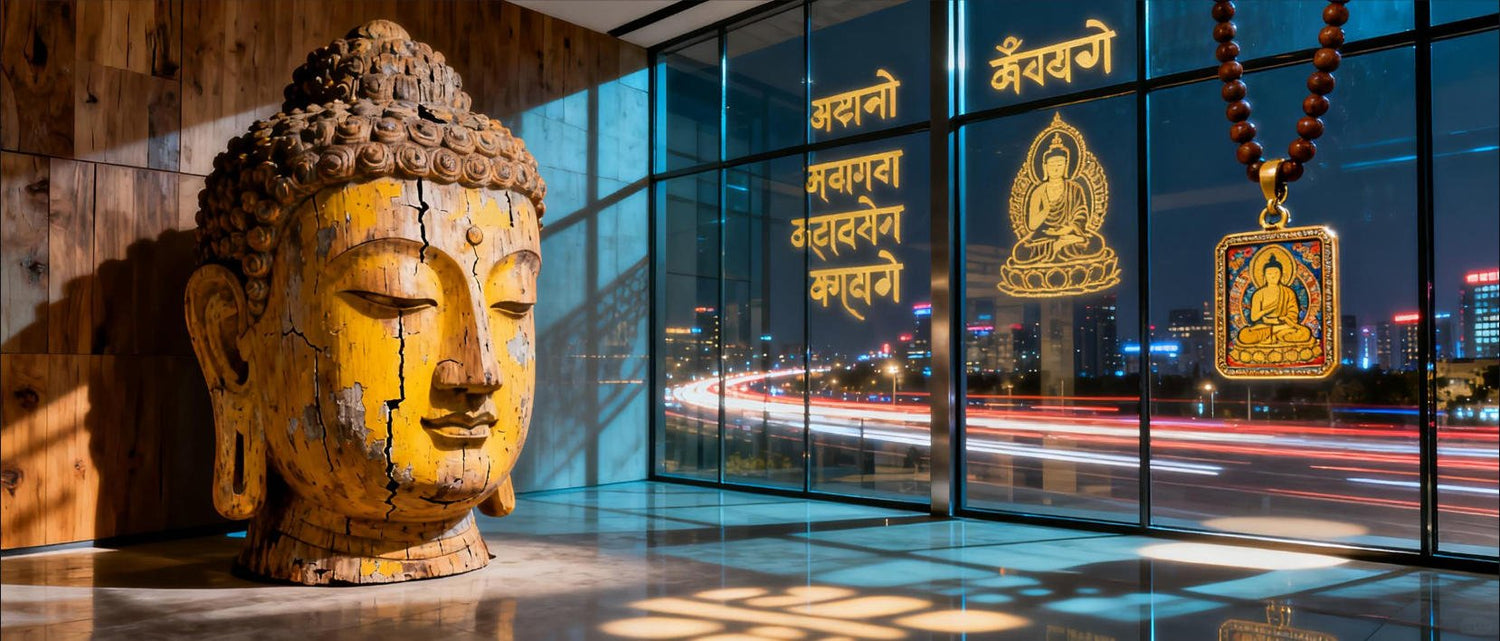
Harmony of Sound and Intention: Using Singing Bowls with Your Mala Practice
The first time you hear a Tibetan singing bowl's pure tone bloom in the air around you, something primal within recognizes this sound—not as entertainment, but as homecoming. When this ancient sound technology joins forces with your mala practice, you're not just meditating; you're orchestrating healing at cellular levels.
At Buddhabelief, we've witnessed how combining these tools creates what Himalayan masters call nada yoga—the yoga of sound—where vibration does the heavy lifting of stilling your mind so your spirit can remember its essential nature.
The Science Behind the Sacred Sound
Modern research confirms what Tibetan monks have known for centuries:
-
Singing bowl frequencies between 400-600 Hz stimulate alpha brain waves, the state associated with relaxed awareness
-
The complex harmonic overtones create binaural beats that naturally synchronize brain hemispheres
-
Sound vibration increases circulation and reduces cortisol levels more effectively than silence alone
When you add mala beads to this equation, you create a powerful feedback loop: sound opens the energetic channels, while the beads give your mind a structured path to follow through newly created inner space.
Creating Your Combined Practice: A Step-by-Step Guide
Preparation: The Sacred Container
Place your singing bowl on its cushion before you. Hold your mala in your dominant hand. Take three conscious breaths, smelling the faint metallic scent of the bowl, feeling the familiar texture of your beads. Set your intention—perhaps "clarity" or "release"—and mentally offer it to both tools.
Phase 1: Sound Bath Cleansing (3-5 minutes)
Using the mallet, circle the bowl's rim steadily until the sound sustains itself. Close your eyes and let the vibrations wash over you—through you. Visualize the sound waves dislodging stagnant energy from your cells. Feel it in your bones, your organs, the spaces between. When the sound naturally fades, sit in the resonant silence that follows—often richer than the sound itself.
Phase 2: Mala Journey Through Cleared Space (5-10 minutes)
As the last echoes dissolve into silence, bring your awareness to your mala. Begin moving through the beads, but notice the difference—your mind feels like a freshly cleaned room, the usual mental clutter temporarily suspended. Each mantra or breath now travels through unobstructed space.
Phase 3: Integration with Pulsed Sound
After completing your mala round, gently strike the bowl once. As the single tone blooms and fades, rest in meditation. This final sound seals your practice, integrating the insights gained during your bead journey.
Advanced Techniques for Deepening Practice
Chakra-Specific Sound Work
Match specific mala beads to chakra points while sounding the bowl:
-
Root chakra (first bead): Strike bowl once, feel vibration in tailbone
-
Heart chakra (54th bead): Sustain bowl tone while holding bead over heart
-
Third eye (108th bead): Fade bowl tone as you complete practice
Mantra-Infused Sound Creation
Chant "Om" into the bowl as you play it, then continue the mantra silently as you work through your mala beads. The vibration continues internally long after the external sound ceases.
Healing Others with Combined Modalities
Place your mala around a loved one's wrist while playing the singing bowl near areas of discomfort. The beads maintain energetic connection while sound provides vibrational massage.
Choosing Tools That Work in Harmony
For Your Singing Bowl:
-
Look for seven-metal alloys (traditional composition)
-
Test that the fundamental tone resonates with your body
-
Choose a size that feels substantial but manageable
For Your Mala:
-
Gemstone malas (especially quartz) amplify sound vibrations
-
Wooden malas provide grounding contrast to ethereal sounds
-
Choose bead size that feels comfortable during extended sessions
The Tibetan Perspective: Beyond Technique
In monastery traditions, this combination represents the marriage of:
-
Nada (subtle sound): The singing bowl's audible vibration
-
Japa (repetitive remembrance): The mala's rhythmic counting
-
Shunyata (emptiness): The silent space between and after sounds
Together, they create a complete cycle of manifestation (sound), practice (beads), and dissolution (silence)—mirroring the cosmic cycle of creation.
Common Challenges and Solutions
"The bowl stops singing quickly"
-
Use consistent pressure and speed when circling the rim
-
Try different mallets—wood, felt, or rubber-covered
-
Practice on a stable, vibration-absorbing surface
"I lose focus switching between tools"
-
Simplify: strike bowl once to begin and end mala practice
-
Let the sound be background rather than foreground
-
Practice transitions during shorter sessions
"The vibration feels overwhelming"
-
Start with smaller bowls and shorter sessions
-
Play the bowl at a distance rather than close to your body
-
Ground yourself by placing feet flat on floor during practice
Creating Personal Rituals with Sound and Beads
Morning Awakening
Begin your day with three singing bowl strikes while holding your mala—setting intention with each tone: clarity, compassion, courage.
Evening Release
After work, use the bowl to "sound away" the day's stresses, then use your mala to count breaths of gratitude.
Full Moon Ceremony
Take both tools outside under moonlight—sound the bowl toward the moon, then meditate with your mala, absorbing lunar energy.
The Transformative Results of Consistent Practice
Within weeks, practitioners typically experience:
-
Deeper, more rapidly accessed meditative states
-
Enhanced sensory awareness during daily activities
-
Increased sensitivity to subtle energies in environments
-
Greater emotional resilience through challenging situations
-
Vivid, symbolic dreams indicating subconscious processing
Your Invitation to Sonic Exploration
The combination of singing bowl and mala is more than technique—it's an exploration of consciousness itself. Some days the sound will lead, other days the beads will guide. The magic happens in the spaces between, where intention meets vibration, and practice becomes presence.
Ready to explore the symphony within? Discover our curated collection of traditional Tibetan singing bowls and companion malas—each set chosen for harmonic compatibility and blessed to support your journey into sound-based meditation.





